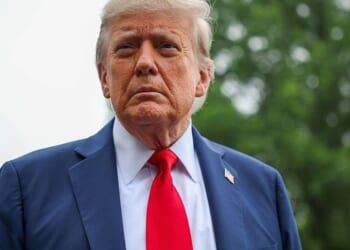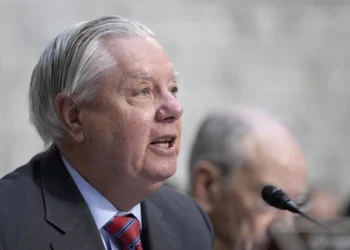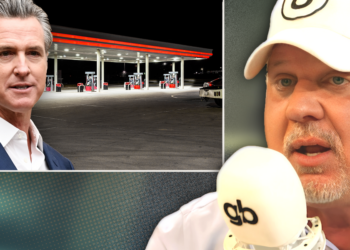Negotiations are underway between the United States and the European Union over a new trade deal; both sides publicly hope it will end their trade war.
Officials on both sides have expressed confidence that a deal will be reached before the July 9 deadline invoked by President Donald Trump, which will trigger a tariff hike on EU imports to 50%.
Since taking office on Jan. 20 for his second term, Trump has imposed an array of tariffs globally, even on countries and entities — like the EU — widely regarded as allies. Trump has framed tariffs as a tool to lure factories back to America, raise money for the Treasury Department, and strike more favorable trade agreements with other countries.
As for EU tariffs, Trump initially set the deadline for June 1 but agreed to delay it after a conversation with European Commission President Ursula von der Leyen.
The actual progress of the negotiations, however, depends on who you ask.
While there have been regular talks between U.S. and EU negotiators, periods of rhetorical napalm flare up regularly.
In May, Trump claimed the EU was “very difficult to deal with” and threatened a 50% tariff on all products. Treasury Secretary Scott Bessant later said the president believed the bloc’s proposals were not of the same quality as those from other trading partners.
The EU’s approach has been more measured.
Commissioners have called the tariffs “unjustified and illegal” while emphasizing the need for respect and mutual dialogue. They’ve pushed for a “zero for zero” tariff outcome but warned about counter-tariffs if no resolution is reached.
At the mid-June Group of 7 Summit, von der Leyen emphasized progress on Bluesky: “We instructed the teams to accelerate their work to strike a good and fair deal. Let’s get it done.”
Trump felt otherwise.
“I don’t feel that they’re offering a fair deal yet,” the president told reporters on Air Force One. “They’re either going to make a good deal, or they’ll just pay whatever we say they’ll have to pay.”
Commerce Secretary Howard Lutnick later said he was “optimistic” about a potential agreement, but expected it to be at the “very, very end [of the negotiations window].”
The EU believes Trump’s tariffs will cover $434 billion of European products, including steel and aluminum-made items such as vehicles. It has threatened $107 billion in tariffs on alcohol, vehicles, planes, and agricultural products.
There are also non-tariff barriers, such as the EU’s Digital Markets Act provisions, that cover American Big Tech companies such as Apple, Amazon, Meta, and Google. Tech companies have been fined $800 million for Digital Markets Act violations.
The economic stakes are high for both sides.
The EU is America’s biggest trading partner. Last year, it sent $606 billion in goods to the U.S. and imported $370 billion.
But the relationship has become complicated since the end of former President Barack Obama’s administration, as populism became more powerful on both sides of the Atlantic. In 2014, the EU ended talks about a free trade agreement with the U.S. due to a dispute over food standards. Negotiations were eventually restarted, but the EU declared them “frozen” when Trump won the 2016 election.
However, Trump attempted to negotiate a new deal with the EU during his first administration without success. Former President Joe Biden’s administration reached several interim agreements with EU negotiators but clashed on electric vehicle tax credits and labor commitments, according to a Congressional Research Service report released this year.
Economists believe the latest round of negotiations will be even more difficult, thanks to political fragmentation, shifting trade goals, and digital regulation.
Swedish economist Johan Norberg at the CATO Institute told the Washington Examiner that one major problem is that U.S. negotiators keep giving mixed messages.
“Is it about reducing trade barriers, or about cutting trade deficits through purchases of [liquefied natural gas], arms, and soybeans? Or is it a deal on digital services and taxes?” Norberg said. “The U.S. has to make up its mind.”
That may be easier said than done.
Trump makes policy decisions quickly — sometimes at breakneck speed. That puts many, including allies, at a disadvantage, observed Gary Winslett at the Chamber of Progress, because they’re forced to play catch-up. He said the chaotic and unpredictable trade policy is one of the chief complaints from the business community.
Meanwhile, the EU is more deliberate due to its enormous bureaucratic makeup. Michael Brown, a senior research strategist at Pepperstone, said no policy decision is made until a majority of the 27-member bloc agrees. That can put certain countries, such as Germany and France, at odds.
“There are essentially two negotiations taking place, one between EU member states, the second between the EU and the U.S.,” said Brown.
That makes negotiations more difficult.
The U.S. will likely ask European regulators to loosen rules for some businesses, like the DMA. Brown doesn’t see the EU backing away from higher regulatory standards or taxes. Norberg said the EU could agree to buy more liquid natural gas, which member nations will use instead of Russian natural gas. Winslett suggested that Trump wants the U.S.-EU trade deficit to get smaller and to figure out a way to declare “victory,” while the EU wants to avoid kowtowing to the president.
While many believe a deal is likely, it remains unclear what it will ultimately look like.
That frustrates those who believe tariff quotas or protections discourage trade between nations.
John H. Cochrane, a senior fellow at the Hoover Institution, argued that the U.S. should simply lead by example: “It would be best to say, ‘I want to trade freely with you, so there are no tariffs, quotas, or protections over here.’”
TRUMP TAUNTS AYATOLLAH, SAYS US KNOWS HIS LOCATION BUT WON’T KILL HIM ‘FOR NOW’
Norberg said the talks were a golden opportunity to create a trans-Atlantic free trade zone without tariffs or quotas. He portrayed a “mutual disarmament of protectionist measures” as something that would benefit businesses and consumers on both sides of the Atlantic. “That would be a true breakthrough.
“Just do it,” encouraged Norberg.
Taylor Millard is a freelance journalist who lives in Virginia.

















